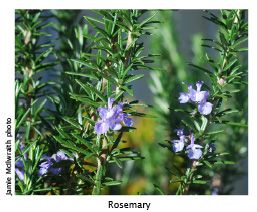Growing conditions: rosemary plants love a warm, very sunny spot with good soil soil drainage. They don’t care how hot and dry it gets, but they really thrive in alkaline soils and love lime. If your rosemary isn’t looking too healthy and you know your soil is acid, apply lime and see what happens. Rosemary doesn’t need much fertilising (just a bit of slow-release fertiliser once a year is enough) and doesn’t like too much fertiliser. Wet, humid summers and badly drained soils can make rosemary plants unhappy.
Varieties: several different varieties of rosemary are sold in garden centres, the most common ones have blue flowers but pink-flowered and white-flowered cultivars are around, so too are prostrate growing forms used as groundcovers, also in a selection of flower colours. There are plenty to choose from.
Cuttings: however, you need not buy plants at all if you know someone with a healthy rosemary bush, as it’s very easy to grow new plans from cuttings. Just take 30cm long tip cuttings in spring, summer or autumn, pop them in a pot of potting mix, and they should strike for you.
Best climate: rosemary loves the Mediterranean climates of Perth, Adelaide, Melbourne, Tassie and southern Australia, but it does pretty well all the way up to Brisbane and in mountain districts, too. It doesn’t enjoy the tropics much, though.
Barbecued whole leg of lamb
You’ll need a barbecue with a hood for this recipe.
1 leg lamb, deboned and butterflied by your butcher
Marinade
1 cup olive oil
2 cups red wine
4 cloves garlic, crushed
1 tablespoon salt
1 teaspoon ground black pepper
1 tablespoon chopped rosemary leaves
juice of 2 lemons
1. Make marinade by combining all ingredients in a bowl and stirring well.
2. Place lamb into a large freezer bag and pour in the marinade. Seal the bag, then place into a second freezer bag and seal. This makes it very easy to turn over the lamb in the marinade. Leave the lamb to marinate for at least 4 hours, or overnight.
3. Preheat both the barbecue grill and hotplate till hot, then remove lamb from its marinade and discard the marinade. Place the lamb on the grill of your barbecue, fat-side down. Let it grill there for 7 minutes. Turn over and grill on the other side for 3 minutes.
4. Transfer the lamb to the hotplate side of the barbecue, turn down the burner heat to low, lower the hood, and don’t lift the hood at all for 25 minutes. If you have a hood thermometer, keep the temperature around 175-180°C.
5. At this stage the meat should be done medium, with a bit of pinkness left in the meat. Let the meat rest 5 minutes, then slice thickly and serve with salads and potato wedges baked in the oven.
Kitchen tips for rosemary
1. Don’t use too much fresh rosemary, it has quite a strong flavour, so go easy when you’re trying it out in a new dish.
2. Rosemary, olive oil and lemon juice are fantastic partners. Try them together when roasting a chicken.
3. Rosemary and potatoes are another great combo. Partly cook some potatoes, then slice or cut into chunks, and use these as a topping for home-made pizza, sprinkled with rosemary and ground rock salt.
4. Cut a solid 30cm stalk of rosemary off a bush, trim off the bottom 15cm of leaves to make a handle, and you have a rosemary brush for the barbecue. Dip the brush in olive oil and brush it onto fillets of chicken or fish cooking on the barbecue.



